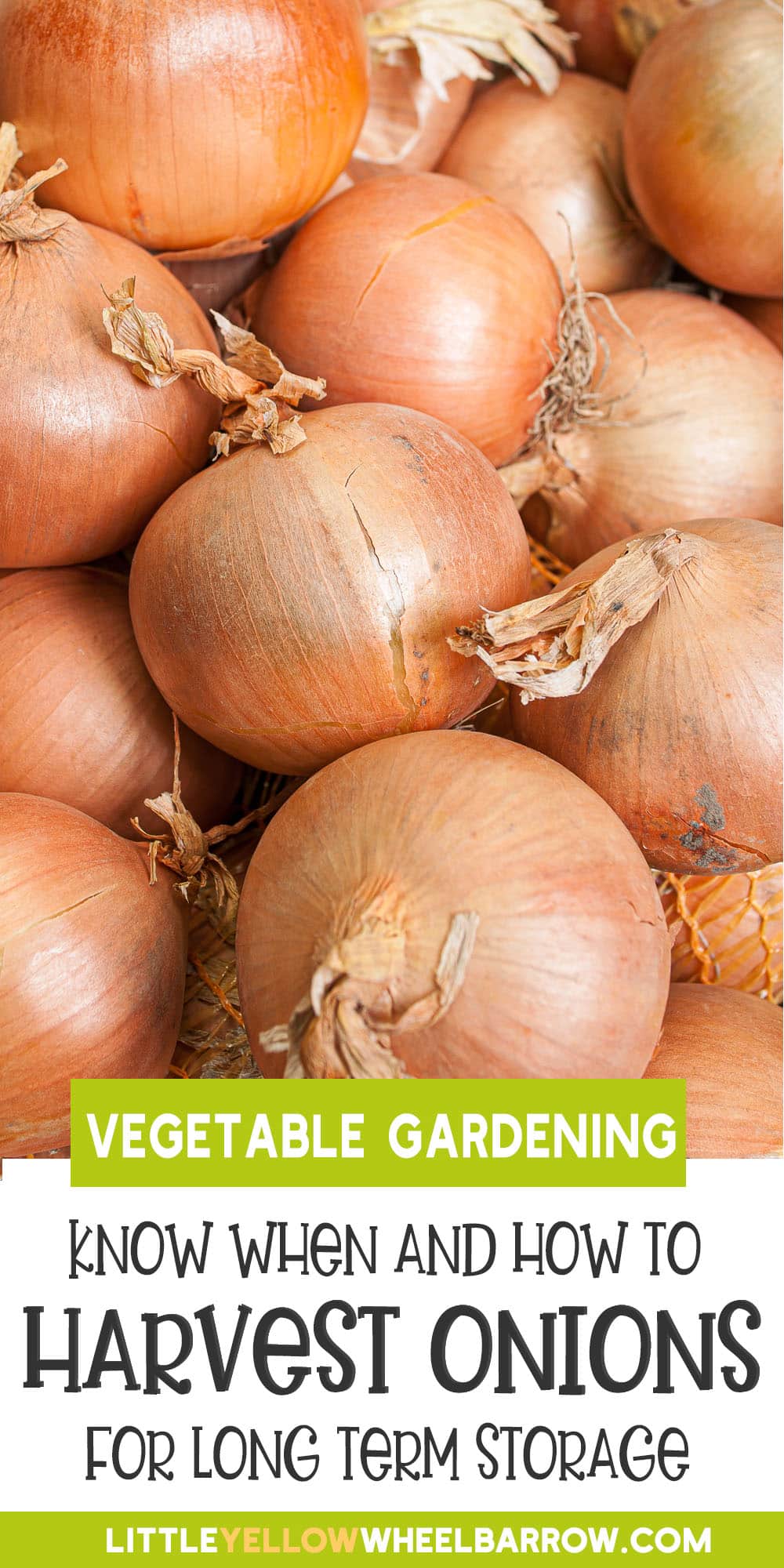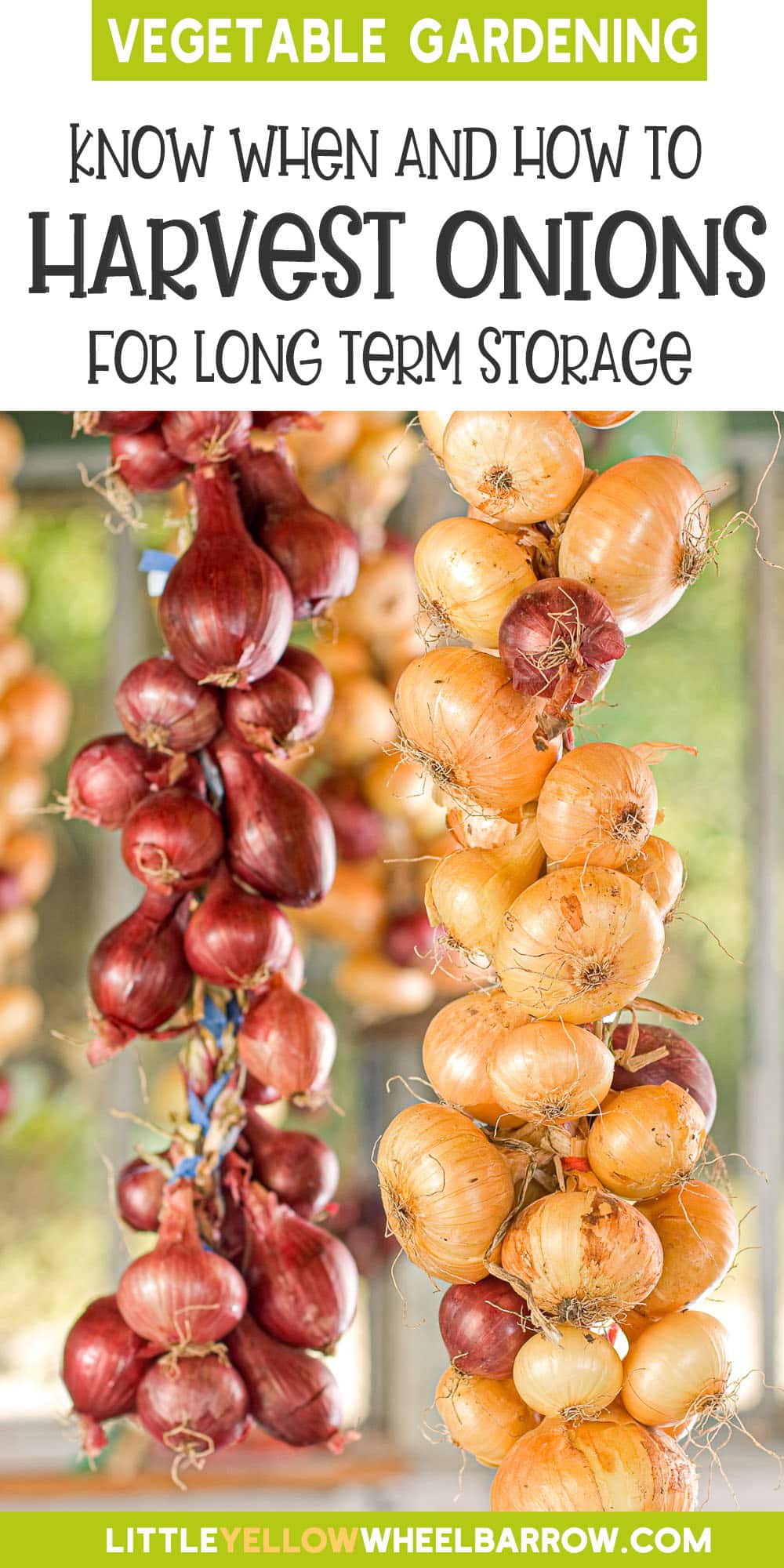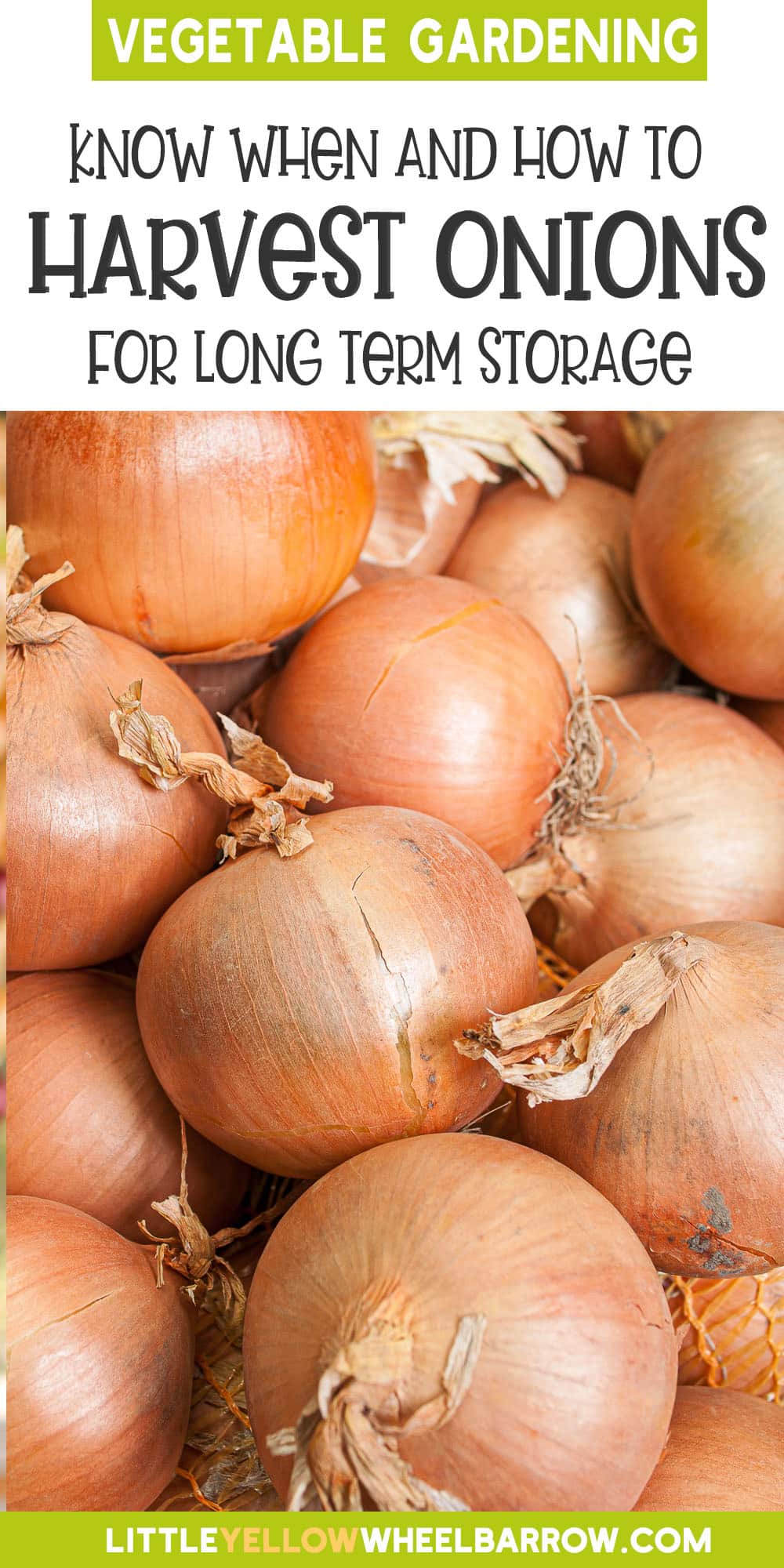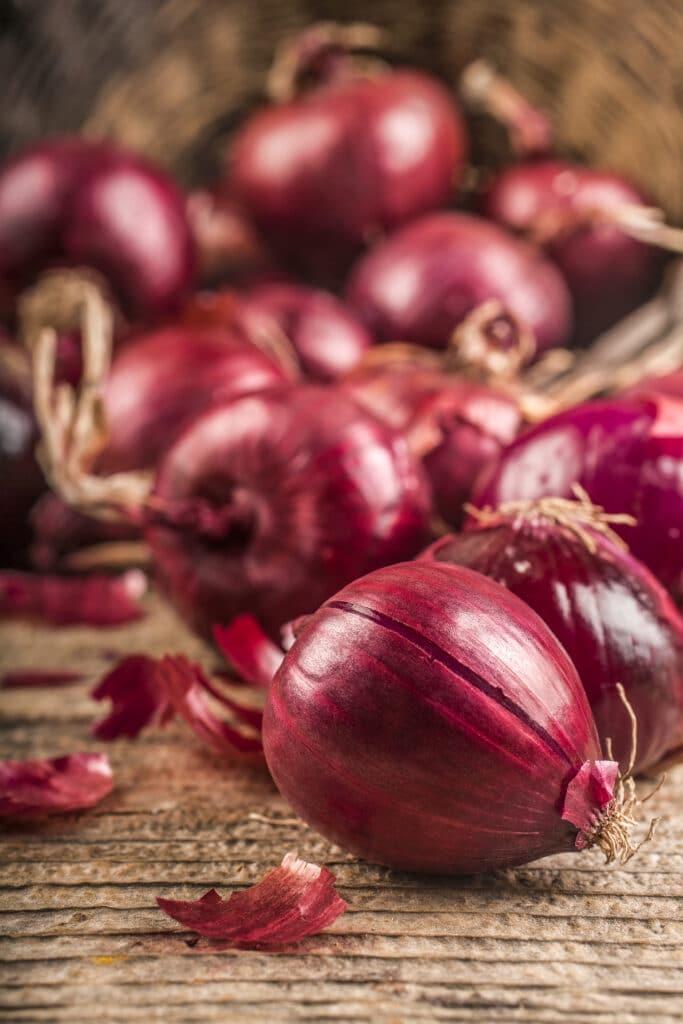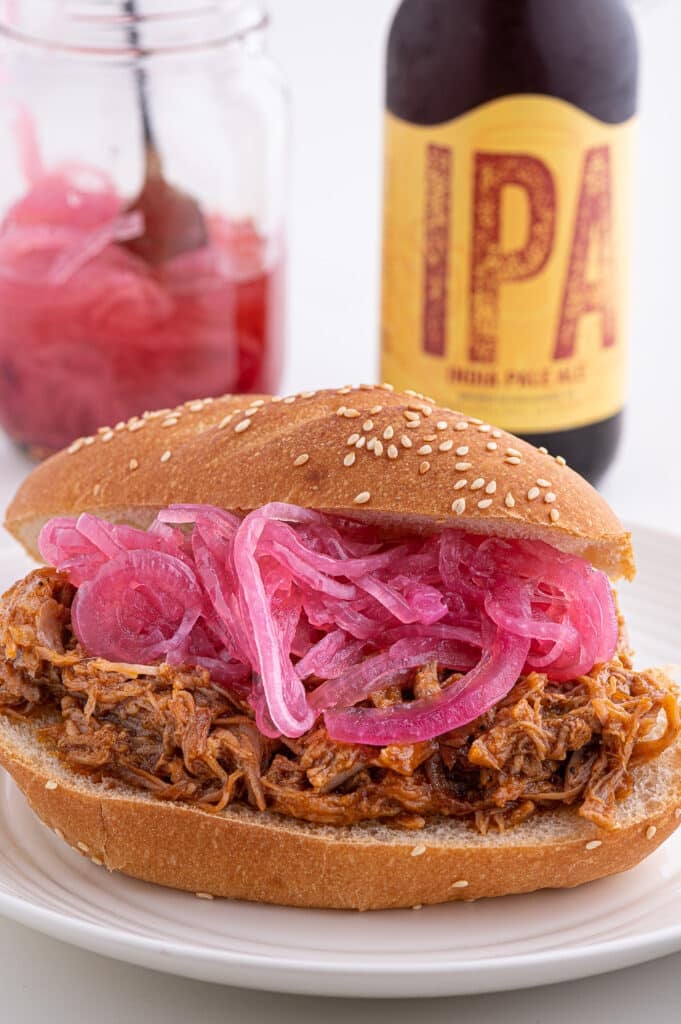When to Harvest Onions for Optimal Flavor – The Full Guide
Onions are a staple for those of us who grow our food for winter storage. They may not be as glamorous as tomatoes or hot peppers, and they may not grow as lovely as leeks or spring peas, but without them, our winter pantries would be sorely lacking in flavor. And for long-term storage, you need to know when to harvest onions for the best flavor and hold times.
This article will take you through all the steps for harvesting onions at optimal times, tips for curing, and storage methods so you can keep your onions over winter without worrying about early rotting.

Why Is It Important To Harvest Onions At The Right Time
Knowing when and how to harvest onions is essential for several reasons. First, harvesting onions at the right time ensures they are at their peak best flavor and have the longest possible storage time. Harvesting onions too early or late can produce bland, less flavorful ones that spoil too quickly.
Additionally, proper onion harvesting methods can help prevent diseases and help reduce the risk of early spoilage. For example, onions harvested too early may not have developed a protective layer, leaving them vulnerable to infection. Alternately, onions harvested too late may have sprouted or gone bad, reducing their storage life.
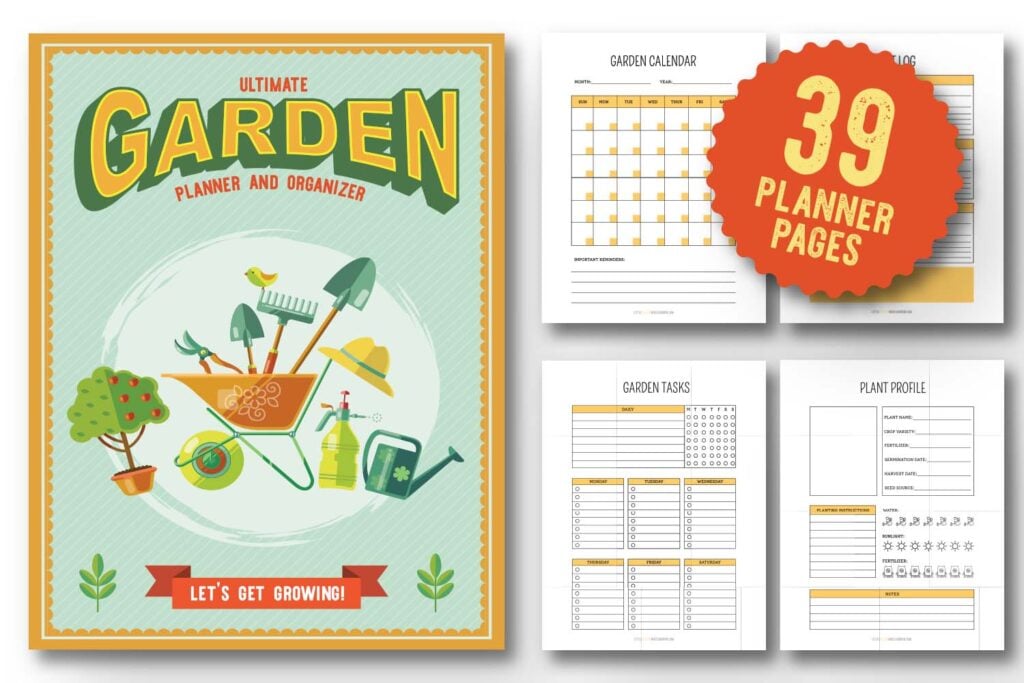
Growing Onions
Onions are a staple crop in many home gardens as they are easy to grow and store. Here’s what you need to know to grow onions:
There are several different types of onions:
Yellow onions: Yellow onions are the most common and have a strong flavor. These are pungent onions, best for cooking down into meals.
Red onions: Red onions have a milder flavor than yellow onions and are often used in salads or as a garnish. (mild onions)
White onions: White onions have a mild flavor and are used in Mexican or Asian cuisine. (sweeter onions)
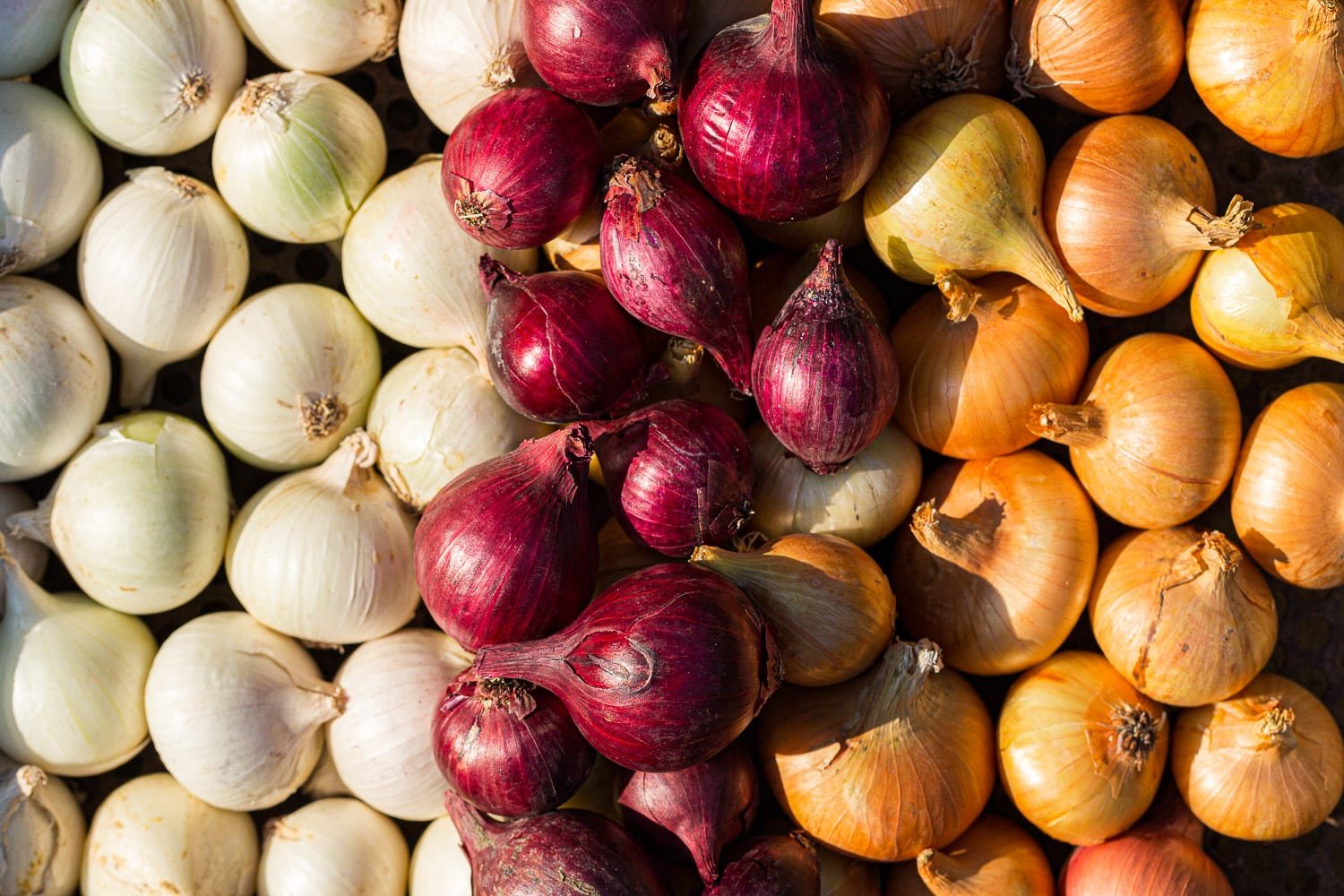
Day-length Onions:
Onions fall into two categories based on their day length requirements: short-day and long-day onions. Where you live and the amount of daylight you receive during the growing season will decide on the onions that will grow best for you.
Short-day onions: Short-day onions require 10-12 hours of daylight to form bulbs and are often grown in southern states.
Long-day onions: Long-day onions require 14-16 hours of daylight to form bulbs and are often grown in northern states.
- Learn More: Are you unsure what day-length onion you need for your area? Check out this handy map from Johnny’s Seeds – it will help you clarify exactly what you need.
General Onion Growth Timelines
The time it takes to grow and harvest onions can vary depending on several factors, such as the type of onion, weather conditions, and growing methods. Here are some general guidelines for growing and harvesting common types of onions:
Spring Onions: 20-30 days
Spring onions are typically harvested when young and have thin green stalks. They can be ready to harvest in as little as 20-30 days after planting.
Bulb Onions: 90-120 days
Bulb onions are the most commonly grown onion, with wide varieties. Generally, bulb onions take around 90-120 days to mature and prepare for harvest.
Sweet Onions: 120-150 days
Sweet onions are a type of bulb onion that has a mild, sweet flavor. They usually take longer to mature than other onions and can take up to 120-150 days to be ready for harvest.
Red Onions: 100-120 days
Red onions are also bulb onions but have a distinct red or purple color. They typically take around 100-120 days to mature and prepare for harvest.
It’s important to remember that these are general guidelines. The exact time it takes for onions to grow and mature can vary depending on the specific variety, growing conditions, and other factors. Therefore, it’s a good idea to consult the seed packet or other resources for more specific information on the variety of onions you are growing.

Steps for Growing Onions:
Here are the steps involved in growing onions:
Choose the right location: Onions require full sun and well-draining soil. Choose a location in your garden with at least 6-8 hours of direct sunlight daily.
Prepare the soil: Onions prefer loose, fertile soil with a pH between 6.0 and 7.0. Add compost or aged manure to improve the soil and provide nutrients.
Plant the onions: Plant onion sets or sprouted onion seedlings in the soil, spacing them 4-6 inches apart in rows. Cover the bulbs with 1 inch of soil.
Water regularly: Onions require regular watering, especially during dry periods. Water deeply once a week, providing 1-2 inches of water.
Fertilize: Onions require regular fertilization to produce healthy bulbs. Apply a balanced fertilizer every 2-3 weeks during the growing season.
Harvest: Onions are ready to harvest when the leaves turn yellow and begin to flop over. Gently pull the bulbs out of the ground and allow them to cure for 2-3 weeks before storing.
Following these steps for growing onions, you can harvest fresh, flavorful onions in your garden.
Learn More: Did you know you can grow onions in pots? You can!

When to Harvest Onions
Knowing when to harvest onions is vital to ensure they are at their peak flavor and have the longest possible storage life. Here are some factors to consider:
Indicators that Onions are Ready for Harvest
The first indicator that onions are ready to be harvested is when the green tops of the leaves turn yellow and begin to flop over. Additionally, the bulbs should feel firm and have stopped growing.
Another way to check if onions are ready to be harvested is to dig around the bulb and check its size gently. If it has reached the desired size, it’s time to harvest tiny onions.
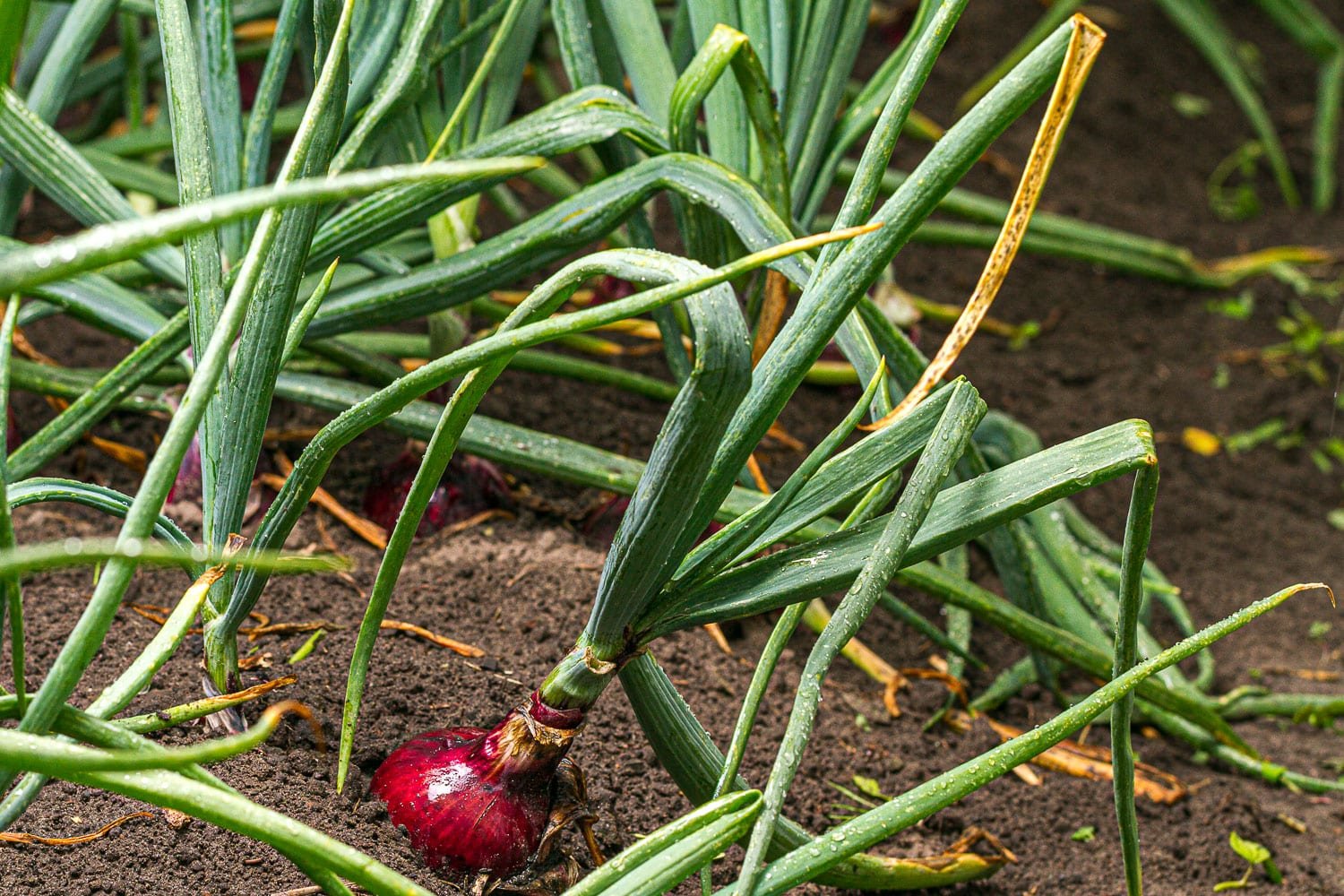
Weather Impact on Harvest Times
The timing of onion harvest can vary depending on several factors, such as weather and onion variety. Generally, onion tops and bulbs are ready to be harvested after 100-120 days of planting. However, this can vary based on the type of onions planted and the weather in the area.
If there has been a particularly wet or dry season, the timing of the onion harvest may need to be adjusted accordingly. Therefore, it’s essential to keep an eye on the growth of the onion plants and bulbs and harvest them when they are mature, rather than simply choosing a calendar date to harvest them.
Tips For Proper Onion Harvest Times
To ensure that onions are harvested at the right time, it’s crucial to keep track of when they were planted and monitor their growth regularly. As mentioned earlier, it’s best to plant onions and harvest them when the leaves turn yellow, the flower stalks and the bulbs feel firm.
It’s also essential to avoid leaving onions in the ground for too long as they may begin to sprout, affecting their quality and storage life. To prevent this, harvest onions promptly when they are mature.
In addition to these tips, check the weather forecast for a few days before harvesting spring onions to ensure they will be dry. Harvesting onions in wet conditions can increase the likelihood of disease and reduce their storage life.
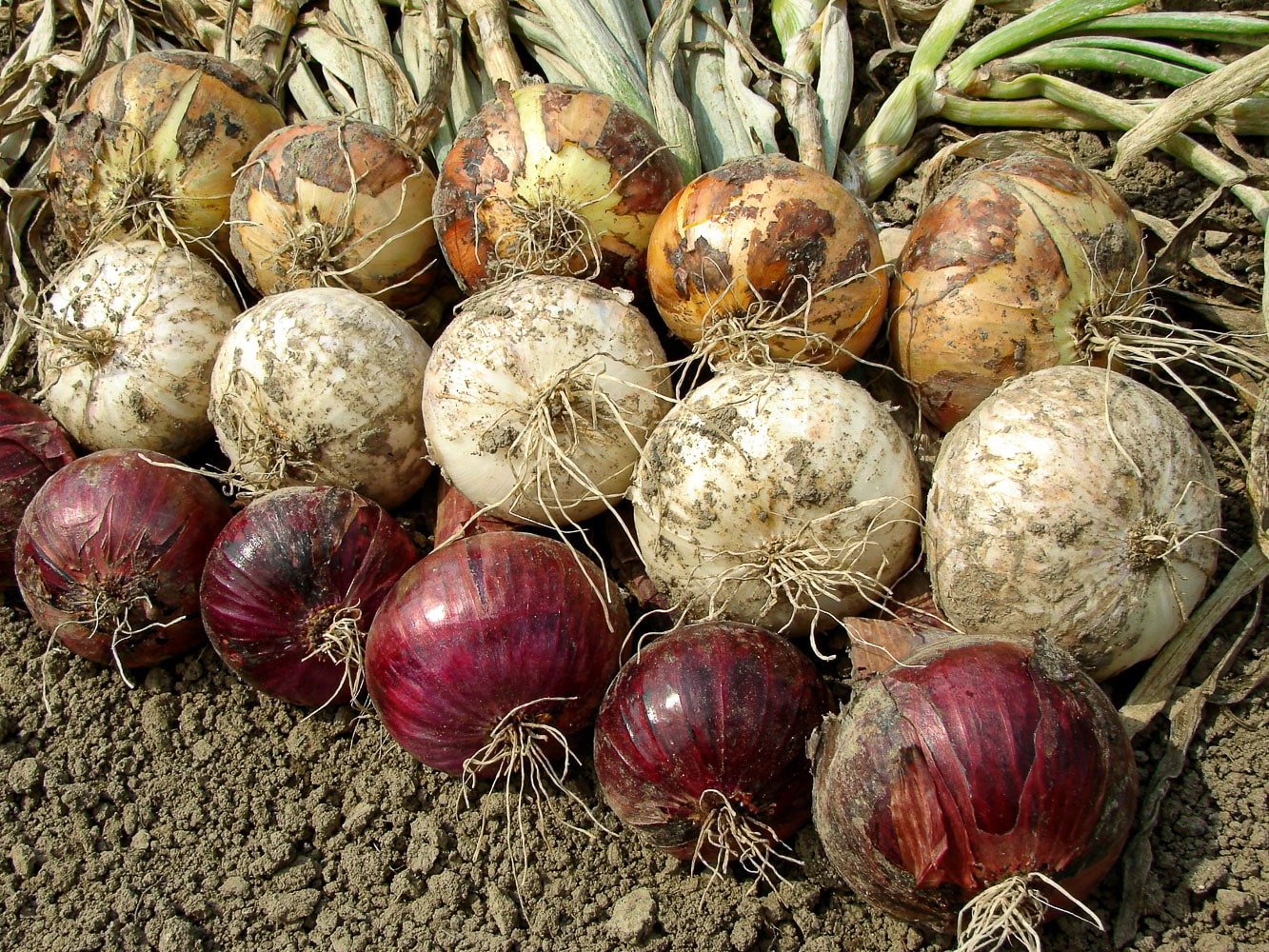
How to Harvest Onions
Harvesting sweet onions is a relatively simple process that involves a few steps:
- Loosen the soil: Before harvesting onions, loosen the soil around the bulbs using a garden fork. Loosening the soil will make it easier to remove them from the ground.
- Pull the onions: Gently pull each bulb out of the ground, careful not to damage them. If the bulbs are difficult to remove, use a garden fork to lift them out of the soil.
- Cut off the foliage: After removing the bulbs, cut off the foliage to about an inch above the bulb. Removing the greenery will help prevent disease and improve the storage life of the onions.
Tools Required For Harvesting Onions
Harvesting onions requires few tools, but having the right equipment can make the process easier. Here are some tools and equipment that make the job easier:
Garden fork: A garden fork is essential for loosening the soil around the onions before harvesting.
Harvesting shears or scissors: These can cut off the foliage from the onion bulbs.
Harvesting bag or basket: A bag or basket can collect the harvested onion bulbs.

Tips for Harvesting Onions Without Damaging Them or Leaving Them Vulnerable to Disease:
To harvest onions without damaging them or leaving them vulnerable to disease, consider the following tips:
Handle the bulbs gently: Onion bulbs are delicate and easily damaged. Handle them gently when pulling them out of the ground or transporting them to prevent bruising or cutting.
Avoid harvesting in wet conditions: Harvesting onions wet can increase disease risk and reduce storage life. Instead, wait until the soil is dry before harvesting.
Store onions in a cool, dry place: After harvesting, store onions in a cool, dry place with good air circulation. A cool, dry location will help prevent disease and ensure the onions last as long as possible.

How to Store Harvested Onions
After harvesting onions, storing them properly ensures they last as long as possible. Here are some tips for keeping onions:
Curing Onions For Long Term Storage
Curing onions is essential in storage as it helps them dry out and develop a protective layer that prevents disease. Here’s how to cure and store onions:
Cure the onions: Spread the onions out in a dry, well-ventilated area, such as a garage or covered porch. Allow them to dry out for two to three weeks until the necks are completely dry.
Remove any excess dirt: After curing, gently brush off any excess dirt or loose skin from the onions.
Store the onions: Store the onions in a cool, dry place with good air circulation. Avoid storing them in plastic bags or airtight containers, which can cause moisture buildup and increase the disease risk.

Onion Storage Methods
There are several ways to store green onions, including hanging them up or keeping them in a cool, dry place. Here are some options:
Hanging onions: Tie them together in bunches of four or five and hang them in a cool, dry place with good air circulation.
Storing in a mesh bag: Place the onions in a mesh bag and hang them up in a cool, dry place.
Storing in a cardboard box: Place the onions in a cardboard box with good ventilation and keep them in a cool, dry place.

Tips for Ensuring that Onions Last as Long as Possible:
To ensure that onions last as long as possible, consider the following tips:
Store onions in a cool, dry place: Onions should be stored in a cool, dry place with good air circulation. Avoid storing them near sources of heat or moisture.
Check onions regularly: Check the onions regularly for signs of spoilage, such as soft spots or mold. Remove any onions starting to go bad to prevent them from spreading to the others.
Don’t store onions near other produce: Onions release ethylene gas, which can cause other produce to spoil more quickly—store onions separately from other fruits and vegetables.
By following these tips for storing onions, you can ensure they last as long as possible and stay fresh and flavorful for up to three months.
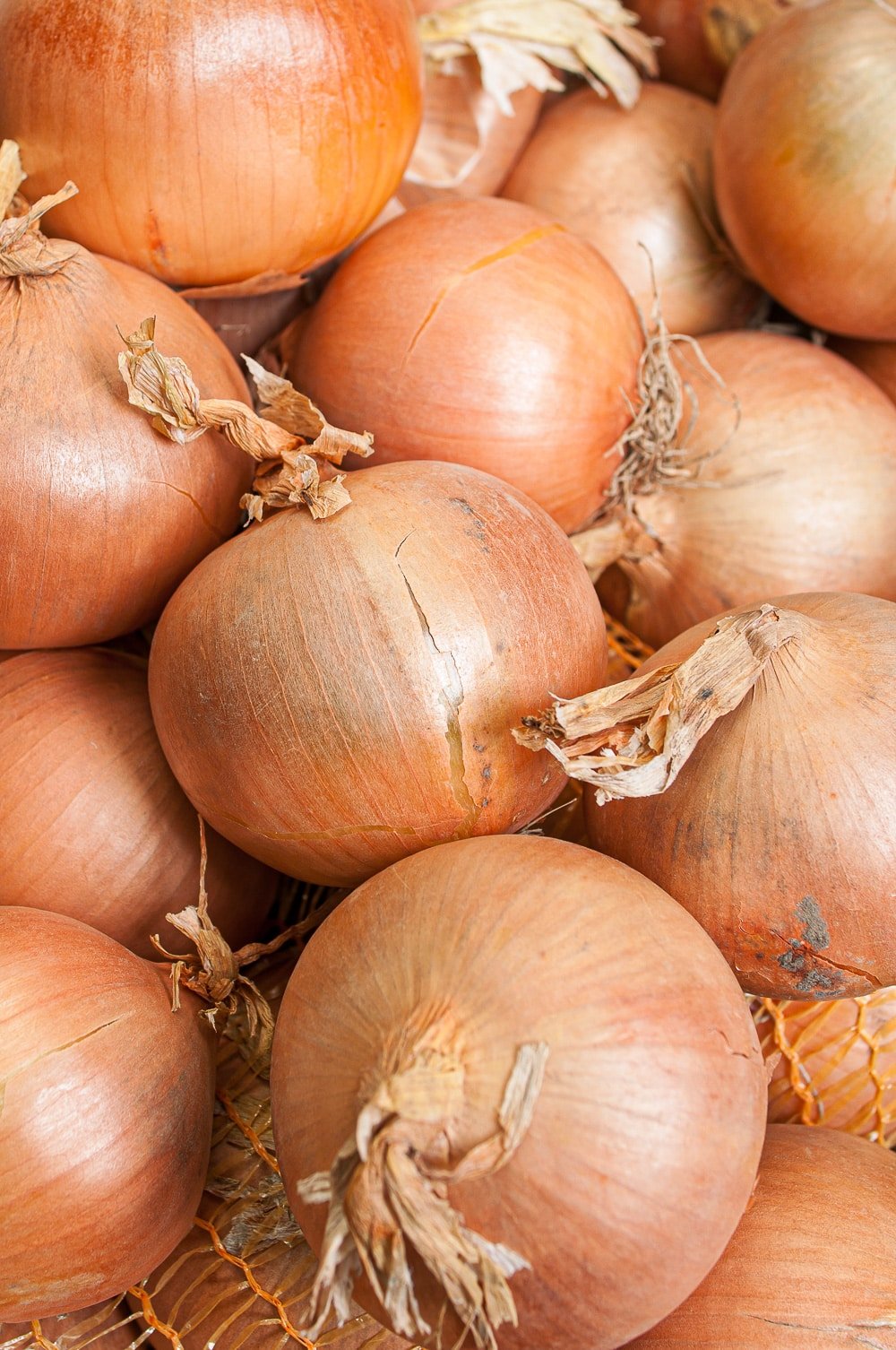
Happy Onion Harvest!
Harvesting onions at the right time ensures a successful crop yield. Waiting too long to harvest can produce soft and mushy onions, while early harvesting can lead to small and underdeveloped bulbs.
The key to harvesting onions at the right time is to pay close attention to the plant’s growth stages and be aware of the signs of maturity, such as yellowing foliage and a softening neck. By waiting until the onions have fully matured and stored properly, you can enjoy this vegetable’s full flavor and nutritional benefits until next spring.
Looking For More Vegetable Harvesting Posts?
We have lots of informative posts about best practices and timing for harvesting all kinds of crops:

Author: Laura Kennedy
Writer & Owner of Little Yellow Wheelbarrow
Laura is a highly skilled gardener and fervent flower enthusiast. Despite her playful battle with plant spacing guidelines, Laura’s work inspires gardeners to create thriving, beautiful spaces that reflect both creativity and sustainability.


